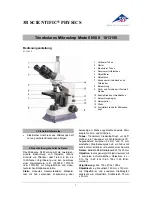Reviews:
No comments
Related manuals for ECLIPSE L200ND / ECLIPSE L200N

SZ-ADD
Brand: Olympus Pages: 16

PickUp-ToF
Brand: Surface Concept Pages: 14

104-CLED
Brand: National Pages: 6

106
Brand: National Pages: 8

Asylum Jupiter XR
Brand: Oxford Pages: 24

N180 1013150
Brand: 3B SCIENTIFIC PHYSICS Pages: 24

Science MTL-201
Brand: Bresser Pages: 16

National Geographic 9119100
Brand: Bresser Pages: 20

National Geographic 9039100
Brand: Bresser Pages: 32

MED 25
Brand: Levenhuk Pages: 6

easyScan E-STM
Brand: Nanosurf Pages: 48

OPMI PRO magis
Brand: Zeiss Pages: 64

3000-LED-SPH
Brand: Accu-Scope Pages: 20

M834 Series
Brand: Omax Pages: 21

CHA-P
Brand: Olympus Pages: 20

Cell Observer spinning disk confocal
Brand: Zeiss Pages: 9

44341
Brand: Celestron Pages: 12

1005436
Brand: 3B SCIENTIFIC PHYSICS Pages: 12

















